Gallery: NOνA construction
Close to the Canadian border, near an area known as the Boundary Waters, scientists are building an experiment to discover how neutrino masses stack up. They aim to get closer to understanding how matter came to dominate antimatter in our universe.
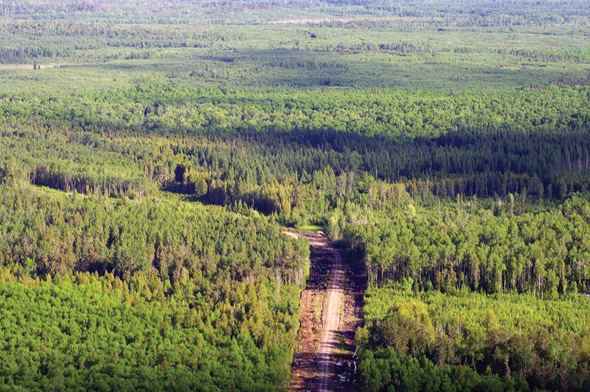 |
Neutrino science meets Minnesota wilderness
by Christine Herman
Luke Corwin traveled along a gravel road winding through woods populated with more lakes and ponds than people. His excitement grew as the giant building that will house his experiment came into view. Here in northern Minnesota, near an area known as the Boundary Waters, he might help discover how the universe became populated with planets and people.
Corwin is a member of the NOνA collaboration, which has been pushing back the Minnesota wilderness for 15 months to make room for a particle detector nearly the length of a professional football field. In 2013, Corwin, a University of Indiana postdoc, and 140 collaborators from 24 institutions will start using the detector to peer at particles too small for even the worlds strongest microscope to see: neutrinos.
Physicists have been dreaming about this project for over a decade, Corwin says, reflecting on his college days when he first heard about NOνA. Now I get to be a part of making it a reality.
Like the fur-clad guides of old that mapped the areas rivers and lakes, NOνA experimenters expect to make important observations that prepare the way for the next generation of neutrino experiments, which aim to answer some of the most fundamental questions in physics.
There was something that caused the big bang to produce more matter than antimatter, so that we could have stars, galaxies, planets, you and me in the universe today, says Mark Messier, Corwins advisor and the NOνA experiments co-spokesperson. It may be that neutrinos tipped the balance between matter and antimatter, and NOνA will begin the study of this possibility.
After a year of construction challenges unique to the sites remote northern location, contractors put the final touches on the NOνA building in April and handed the keys over to the collaboration.
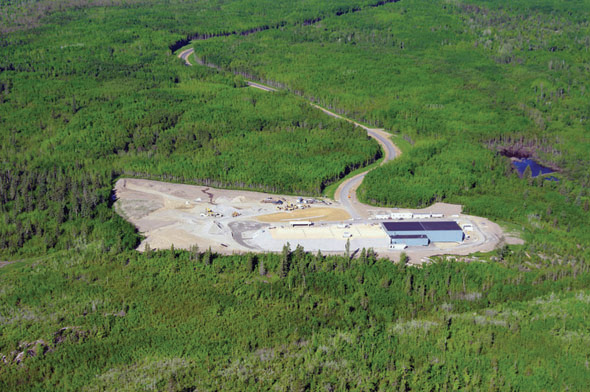 |
|
| The NOνA detector facility, under construction near Ash River, Minn., will house a 15,000-ton particle detector. | |
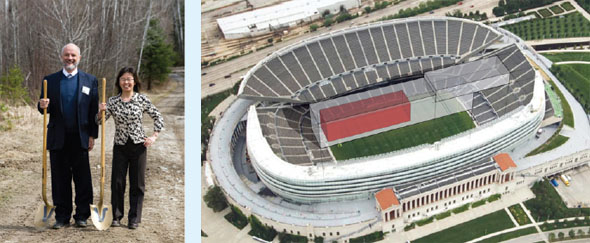 |
|
| Left: Fermilab Director Pier Oddone and Deputy Director Young-Kee Kim celebrate the groundbreaking for the NOνA neutrino experiment on May 1, 2009. Right: The NOνA Far Detector (red) and surface building placed inside Soldier Field stadium in Chicago, for a sense of scale of the detector size. | |
 |
|
| Left: Groundbreaking in Minnesota. Right: Physicists will analyze the mysterious behavior of neutrinos sent straight through the earth from Fermilab in Illinois to the NOνA detector in Minnesota. The neutrinos travel the 500 miles in less than three milliseconds. Images: Fermilab, NOνA collaboration | |
Scientists and engineers are now preparing to install detector components. The new building will house a 15,000-ton detector, equivalent to the weight of 37 fully loaded Boeing 747 jumbo jets. It will sit at the end of a particle beam generated 500 miles away at the Department of Energys Fermi National Accelerator Laboratory in Batavia, Illinois. A smaller, 222-ton detector, equivalent to roughly half the weight of a jumbo jet, will sit on the Fermilab site, near the particle beams origin.
NOνAs far detector is a test case in making a large-scale particle detector predominantly of plastic, a cheaper alternative to other detector materials. The detector comprises 385,000 cells of extruded, highly reflective plastic PVC filled with mineral oil that reflects light caused by a neutrino striking an atom in the liquid. Making materials pure enough to prevent false signals yet sturdy enough to avoid bowing and last more than a decade has been the job of a plastics company in Wisconsin and a chemical company in Indiana.
It never ceases to amaze me that we can take this ordinary stuff, wire it all together, turn it on and see neutrinos, Messier says. We are all looking forward to our first data in 2013.
Scientists have reason to believe that neutrinos, with their ability to change types, could help explain how matter came to dominate antimatter in our universe. Previous experiments have found proof of neutrinos transforming from one type into another. Most recently, Japans T2K experiment announced the first sighting of muon neutrinos transforming into electron neutrinos, the last unconfirmed neutrino transformation.
The high transformation rate indicated by the T2K experiment means that neutrinos continue to be the prime suspect for the tipping point for a matter-filled universe, an area of study accessible to NOνA. The result also means NOνA can take the next major step in understanding neutrinos, determining whether one light and two heavy neutrinos exist, or one heavy and two light ones.
The T2K result means its likely that NOνA will be able to solve the question of the neutrino mass ordering, a question that no other neutrino experiment in operation or under construction can address, Messier says.
NOνAs mass hierarchy measurement will help scientists to narrow the list of neutrino models that try to explain how the early universe evolved to a state where most antimatter disappeared, leaving only matter.
The excitement and pioneering spirit of NOνAs quest for out-of-this-world answers resonates with the down-to-earth types that live and work in the north woods. Joe Froehlingsdorf, NOνAs blasting superintendent from Hoover Construction Company in Virginia, Minnesota, never thought he would become an ambassador for neutrinos. Yet more than once he has fielded local residents physics questions, which he is able to answer thanks to chatting with scientists.
Theyre always hitting us up, asking what a neutrino is, what our project is all about, Froehlingsdorf says. Theyre definitely excited to see whats happening.
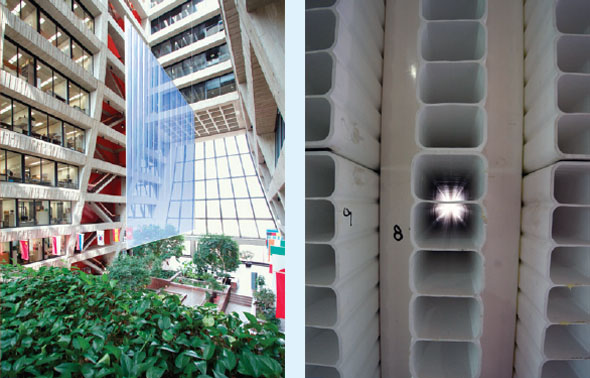 |
|
| Left: An illustration of how large one 51.2-foot-by-51.2-foot plane of the far detector would be if it were hanging in Fermilabs 16-story Wilson Hall. Right: Reflective plastic tubes filled with mineral oil will help record bursts of light given off by neutrinos striking an atom in the liquid. | |
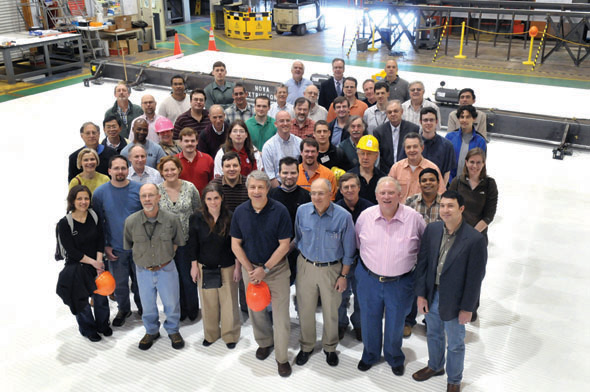 |
|
| The experiment involves about 180 scientists and engineers from 28 institutions. | |
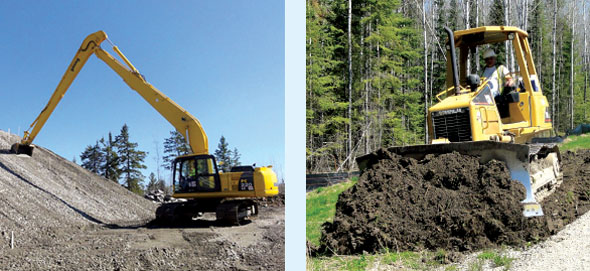 |
|
| Rock removed to dig a 40-foot-hole to house the detector and building was repurposed for the sites berm and road. | |
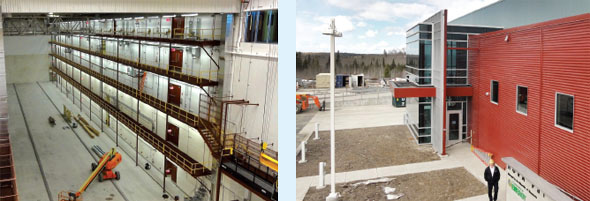 |
|
| Left: Interior of the detector hall. The detector will be installed in 2012. Right: The building housing the NOνA far detector, which weighs as much as 150 fully loaded school buses. | |
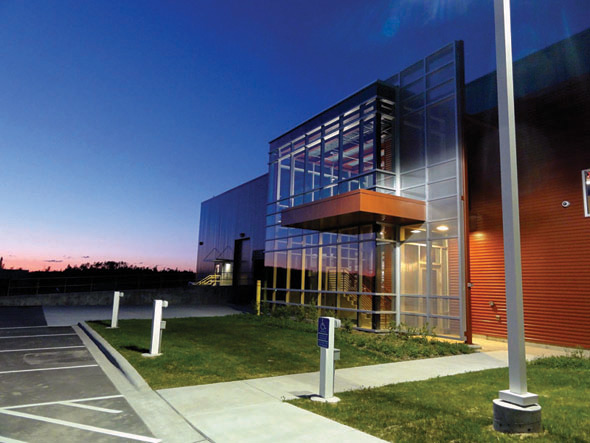 |
|
| Completed NOνA experiment building in Minnesota. | |
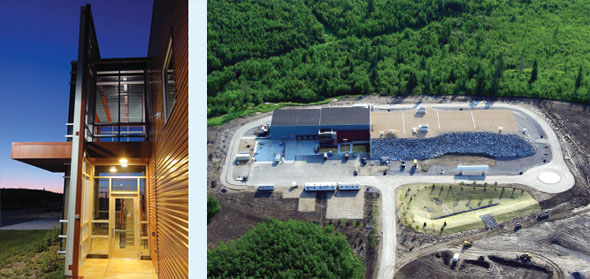 |
|
| Left: Completed NOνA experiment building in Minnesota. Right: The roof uses a six-inch layer of barite, which is 60 percent heavier than a six-inch layer of common granite, to shield the detector inside from cosmic rays. NOνA is a two-detector experiment with the smaller of the two, a 200-ton near detector, at Fermilab, and a 15,000-ton far detector 503 miles away in Ash River, Minn. | |
 |
|
| Completed NOνA experiment building in Minnesota. | |
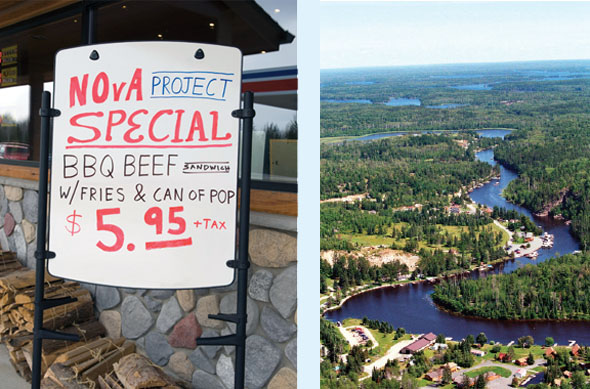 |
|
| Neighbors in Ash River and the surrounding Minnesota towns welcome the NOνA construction project and the extra business it brings to their stores, restaurants, and accommodations. | |
Little by little the neighbors are becoming neutrino savvy. Every time the NOvA collaboration holds a meeting in Minnesota, scientists and engineers reach out to the local community by hosting information sessions at the nearby college or Veterans of Foreign Wars post.
Collaborating physicists often stay at Jims Ash Trail Lodge in Orr, Minnesota, along with local workers, and some inevitably end up chatting in the dining hall that serves a NOνA BBQ beef lunch special. Messier has answered questions at other area bars and restaurants as well as at a community picnic during the 2010 fishing opener.
A number of people came up and asked us about what was going on at the site and with the experiment, he says. Pretty much everyone up there, at least the people Ive talked to, have heard something about it, and they are all curious and supportive and a little bit astonished and proud that their community has a role to play in this basic science.
Indeed, NOνA plays a unique role among the more than a dozen neutrino experiments worldwide. Collectively, they strive toward an explanation for our existence through incremental advances in understanding. Each experiment is a rung on a ladder leading to the final answer.
NOνA is a key step on that ladder. The experiment will examine the worlds highest-power, longest-distance muon neutrino beam. This power and distance give NOνA access to patterns of neutrino behavior that other experiments cant observe.
These patterns will provide crucial information to help the next experiment on the discovery ladder, the proposed Long-Baseline Neutrino Experiment. This billion-dollar-plus experiment would use a neutrino beam traveling at least 800 miles through the earth to determine the difference, if any, between neutrinos and antineutrinos. LBNE is in its early planning phase.
Corwin is eager for the NOνA experiment to make the transition from construction to operation and wonders whether the experiment will make surprise discoveries like so many neutrino experiments in the past. He likens neutrino physicists to ancient explorers who pointed their ships out into the ocean without knowing what they would find beyond the horizon.
Our results will shed light on the neutrino-mass hierarchy, but we dont know what else were going to findthat is the most exciting part of science, Corwin says.
Click here to download the pdf version of this article.


